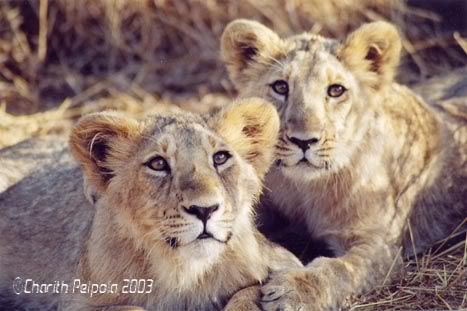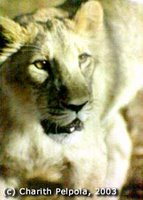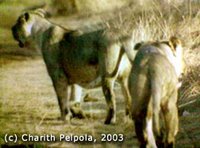 One of the world's most endangered big cats - the beautiful Asiatic Lion - was once widespread from the Mediterranean to India. Today they number just around 300.
One of the world's most endangered big cats - the beautiful Asiatic Lion - was once widespread from the Mediterranean to India. Today they number just around 300.With such a small number of animals - representing the world's entire population - there are so many problems that have arisen for conservationists trying to rescue the species - not least of which is the tiny gene pool. Inbreeding has taken place at such a rate, that 80% of cubs die within the first year because of deformity and poor health.
I experienced this firsthand when I filmed out in the Gir Forest in Gujarat, West India a couple of years ago, for a documentary about the Lions and their relationship with the local tribal communities. Even though the Gir Forest itself is huge, covering an area of 1,400 square kiometres, its just a core zone of 260 square kilometres in which the lions are found. I found that out to my cost - when, after 3 days of tracking the length and breadth of this area, which is thick with dry forest and grassland - we still hadn't sighted a single lion.
Of course we had heard them roaring in the distance and come across a couple of old pugmarks - but not the animal itself. I was getting desperate, because we had run out of time and I even thought about changing the subject of the film to a story about the beautiful jackals (another favourite animal of mine!) that are found in the park.
It was literally on the last afternoon of the last day of filming that they suddenly appeared - a mother, her sister, and three 1-year old cubs - one male and two females. They had emerged from the tall grass to begin the night's hunt, and we found the cubs in a playful mood, rough-housing each other and their mother. But their aunt would have none of it and smacked the male several times with a warning snarl.
We were told by the trackers that the cubs' father was the dominant male of this area, but a younger male had challenged him recently and tried to separate the adult females from him. The oldtimer had been killed - directly as a result of the cramped territories that the males have to constantly fight over in the park. If the new male were to come across the cubs, he would kill them, so as to stimulate their mother to come into breeding condition again.
For their own safety, the cubs are monitored round-the-clock by a patrol of forest rangers, who try to keep the new male away. Healthy cubs are so rare these days, that they just can't afford to let 'nature take its course' anymore. They also told me that this particular mother had given birth to premature cubs before, so these three youngsters were very special.
When I photographed the two cubs below, resting after playtime, they were literally about ten feet away from our jeep (despite centuries of persecution, a strange thing about Asiatic Lions is that they are fearless around humans, and even curious about us). The male is on the left; one of his sisters beside him. Its now been almost three years since I had this magical encounter - I can only hope that they made it to adulthood...

Having spoken at length with the game warden at Gir and representatives of the local tribal communities, namely the Maldhari and the Rabari herdsmen - I was given some interesting perspectives on the problem.
 As far as the tribal communities are concerned, they've obviously had resentment against the lions in the past - the Maldhari were once nomadic herders, driving their livestock from one end of the forest to the other, following good grazing grounds during the changing seasons.
As far as the tribal communities are concerned, they've obviously had resentment against the lions in the past - the Maldhari were once nomadic herders, driving their livestock from one end of the forest to the other, following good grazing grounds during the changing seasons.When the reserve was sanctioned, they were effectively prohibited from moving through the forests anymore. Many left Gir but a lot remained and were forced to settle down and become farmers.
Its these people whom I spoke with, and I got the impression that they were quite proud of the lions. They showed me the protective barricade of vicious-looking thornbushes build around their homes for protection. One farmer told me that one or two of his buffaloes are taken from time to time, but the lions were here long before him, so they have every right to do so. Of course he had a camera in front of him, and I always have to try and figure out if people are saying what they think I want to hear ('for the cameras'), or if they are saying what they really mean. But they seemed genuine enough. Maybe times have changed for some of these people.
 Another Maldhari farmer recounted about the lions' fearless curiosity. As a child he recalled how two adult lions strolled into his village and just sat down, staying for an hour or so just watching the people going about their business - and then wandering back into the bush! Lion-hearted indeed!
Another Maldhari farmer recounted about the lions' fearless curiosity. As a child he recalled how two adult lions strolled into his village and just sat down, staying for an hour or so just watching the people going about their business - and then wandering back into the bush! Lion-hearted indeed!There were plans to move some of the cats from Gir to the Kuno Wildlife Sanctuary, 500 miles away.
This would give the species a much needed chance of diluting their gene pool, especially with future plans of reintroducing captive bred animals from Europe into the wild population.
When you consider that all 300 lions are descended from as few as a dozen individuals, its no surprise to learn that one lion is so genetically identical to another, that they could be identical twins.
As I write this, I also hear that a controversial new reintroduction and resettlement plan for the lions is being hammered into shape - shall post when I find out more.


1 comment:
For more information on critically endangered Asiatic Lions please also visit:
Asiatic Lion Group:
http://pets.groups.yahoo.com/group/Asiatic_Lions/
Asiatic Lion Group Links Section:
http://pets.groups.yahoo.com/group/Asiatic_Lions/links
Asiatic Lion Group Links on Asiatic Lions, Click on "Folders" for more links:
http://pets.groups.yahoo.com/group/Asiatic_Lions/links/Folder_Indian___Iran_001158077222/
Why Should some 10 or 15 lions be sent to Kuno Wildlife Sanctuary in Madhya Pradesh, as soon as possible, please check in " Madhya Pradesh Folder":
http://pets.groups.yahoo.com/group/Asiatic_Lions/links/Folder_Indian___Iran_001158077222/Details_on__KUNO_Wil_001158438437/
Gir Sanctuary, "Gujarat Folder" :
http://pets.groups.yahoo.com/group/Asiatic_Lions/links/Folder_Indian___Iran_001158077222/Details__GIR_Nationa_001158438899/
ASIATIC LION "CRISES" in India (Please see all links collected in this folder)
http://pets.groups.yahoo.com/group/Asiatic_Lions/links/Folder_Indian___Iran_001158077222/ASIATIC_LION__CRISES_001175900857/
Atul Singh Nischal
atulsinghnischal(a)yahoo.com
ASIATIC LION GROUP
http://pets.groups.yahoo.com/group/Asiatic_Lions/
Asiatic Lion Yahoo Group Messages & Links are accessible to all:
http://pets.groups.yahoo.com/group/Asiatic_Lions/messages
Asiatic Lion Yahoo Group Links
http://pets.groups.yahoo.com/group/Asiatic_Lions/links/Folder_Indian___Iran_001158077222/
http://pets.groups.yahoo.com/group/Asiatic_Lions/links
Post a Comment